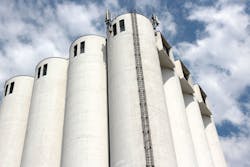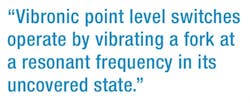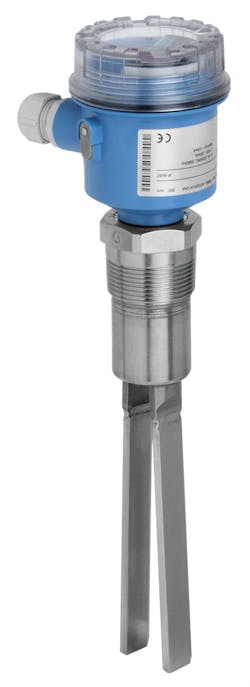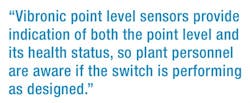Instrumentation for point level and continuous level in solids applications has become more capable with advanced diagnostics, continuous monitoring and verification functions. Here is a look at some recent developments.
Solid level measurement advances
Bins, hoppers, dissolvers, mills, mixers and silos (see Figure 1) are common applications for point and continuous level measurement instrumentation.
Figure 2. An instrument using 80 GHz frequency modulated continuous wave radar, such as this Endress+Hauser Micropilot FMR6, is designed for measuring level in solids.
For continuous level measurement of solids, advances in radar level instruments are making it much easier for companies to stay competitive and improve operational consistency. For example, advanced algorithms in continuous level transmitters for Multi-Echo Tracking optimize continuous level monitoring by dynamically ignoring false levels.
Two types of radars are suitable for level monitoring in solids: noncontact pulse radar and guided wave radar (GWR). With pulse radar, the transmitter sends a microwave pulse. When the microwave energy reaches the material being measured, there is a change of impendence that causes the energy to be reflected.
GWR uses an approximately 1.2 GHz pulsed-radar signal traveling down a guide rod or cable, making it a “contact” device because the rod or cable contacts the solid. The energy reflects back to the transmitter when it encounters a change in dielectric. Air has a dielectric constant (DC) of 1.0, and most bulk solids are above 1.4.
One of the most advanced radar instruments uses 80 GHz frequency modulated continuous wave (FMCW) radar (see Figure 2) for continuous level monitoring. This instrument has a short-wave length of only 4 millimeters (mm), along with a narrow beam path of just 3 degrees. The combination of a short-wave length that performs well in powders and small particle solids, and a narrow beam that does not see or reflect off objects, makes FMCW radar ideal for certain solids applications. FMCW radar provides high accuracy of ±3 mm in solids at a relatively low cost compared with prices from five years ago.
Inventory management has often been difficult in the past due to expensive and unreliable methods using sonar instrumentation. Typically, sonar has overpromised and under-delivered in solids applications.
A better alternative in many applications is to use up to eight radar instruments installed in a large diameter silo or vessel. An average can be calculated from each instrument, and then the average can be converted to volume. The volume of the silo or vessel can thus be managed with accuracies of ±3 mm, at a fraction of the cost of past solutions using sonar.
Applying radar in solids applications
Light, powdery materials such as flour, sugar and powders are often fluidized to avoid buildup on the silo and to keep them from compacting. To fluidize a bed, a gas is bled through the bottom bed of solid particles. As it moves upward in the vessel between the empty spaces of the particles, it affects the aerodynamic drag on each particle. As the flow increases, the drag forces will begin to counteract the gravitational forces and the bed begins to expand and the particles move away from each other. By increasing the velocity of the gas, it will reach a critical point at which the upward drag forces will equal the downward gravitational forces, causing the particles to become suspended within the fluid. At this point, the bed is fluidized and will appear to be in a fluid state. This reduces the density of these bulk solids significantly, up to an 80 percent reduction. GWR is the preferred solution for level measurement, with coated cables recommended to minimize cable damage caused by flour migrating into the cable strands.
Noncontact pulse radar can also be used, providing the advantage of no risk of a cable break or malfunction. However, if extreme clouds of dust form when filling the silo or bin, they can block the radar signal.
To protect both types of instruments from coatings or contamination, an air purge is needed to clean the transmitter horn. A dust bag is another good option when there is air movement inside the silo. A dust bag is often used as it is attached to the body of the transmitter surrounding the horn and keeps all dust particles from collecting on the horn. Since this is a bag, it is able to move with any air movement and the particles that form on the bag are easily shaken off before extreme collection of dust prohibits the transmitter from sending and receiving its transmitted signal.
Grain, corn, beans and feed pellets are often stored in tall silos or bins for distribution and milling. Large concrete silo complexes typically use noncontact pulse radar, while GWR can be used for very narrow bins with support beams. In either case, there must be minimum distance of greater than 2 feet from the transmitter to the silo walls.
Malt tends to be very low in dielectric constant, and its bulk density is low, so GWR is the preferred measurement instrument.
Spent grain left over from brewing processes can be found at breweries, distilleries and ethanol plants. It can be very wet and often steaming, so a noncontact radar unit is preferred to minimize buildup and effects from condensation.
Other guidelines for using radar include:
- Verify hazardous area requirements regarding airborne dust.
- If there is a concrete roof, use a metal launch plate and extension tube through the concrete for both radar and guided wave radar.
- Use an alignment flange/positioner for angle of repose of fill cones. An alignment flange/positioner can change the angle of the transmitted signal to match the angle of repose of the product as it fills or empties. The purpose is to increase the reflectivity of the signal and allow for less of the signal to reflect in spurious directions. An increase in reliability is realized when alignment is achieved.
- Use a beam-angle calculator to avoid objects and the side wall, which can become disturbances when in the beam path. A beam path calculation during each review of the installation can be done easily by plant personnel or sales support individuals.
Using ultrasonics
Ultrasonics use a sound wave that is mechanically coupled to the reflection of solids based on the change in density from air. Recent enhancements allow for self-cleaning of the sensor. This is achieved by detecting a buildup of dust on the membrane as the membrane vibration is dampened. The unit then increases the vibration to shake off the dust on the membrane, allowing it to reliably measure the solids level.
The challenge with ultrasonics comes from extreme buildup caused by moisture that does not allow the membrane to vibrate particles from the surface. Ultrasonic sound waves are also attenuated by changes in temperature. Modern ultrasonic sensors are able to compensate for the ambient temperature around the transmitter, but not as the temperature changes in the vapor space to the product. That often introduces more error than allowable. Radar is not concerned about ambient temperature within its limits.
Figure 3. Point level switches, such as this Endress+Hauser Vibronic Soliphant FTM50, can detect finegrained bulk solids.
Point taken
Point level measurements are often needed, even with continuous level monitoring, to provide backup detection of overfilling or empty silos (see Figure 3). Fortunately, point level switch pricing is quite low due to the use of mature technologies. These switches are also becoming more compact, easing installation.
As with radar instruments, advances in technology have made point level switches more capable without increasing their cost. For example, one available switch can be used in silos containing fine-grained or powdery solids, and with other low bulk density materials. Typical applications are detecting level of cereals, flour, cocoa, sugar, animal feed, dye powder and chalk.
Vibronic point level sensors provide indication of both the point level and its health status, so plant personnel are aware if the switch is performing as designed. Additionally, new diagnostic methods can monitor the health and status of sensors. This allows for diagnostic alerts to notify operators if the switch is not able to perform as expected, reducing down time and overfill potential.
Advanced diagnostics
Instrumentation for solid level applications are now available with advanced monitoring and diagnostic functions. These technologies make the life of a maintenance technician easier and help meet regulations calling for regular calibrations, along with verification of proper operation.
For example, Endress+Hauser’s Heartbeat Technology can monitor a radar transmitter for dust buildup on the horn or antenna and evaluate the return amplitude or strength of the returning signal. In dusty environments, it is common for buildup to appear on the antenna and weaken the propagation of the signal transmission when it is exiting the antenna.
The antenna can begin to get extreme buildup over time until the signal strength is so low that a loss of signal can occur. One transmitter on the market offers advanced diagnostics to solve the problem. Evaluating the “area of incoupling” from the display menu at the time of installation allows the operator to set an expected range for the allowable attenuation or signal loss (measured in dB); typically, a 10 to 15 percent decrease is chosen as a default. This calculated variable can be monitored in a programmable logic controller (PLC) or distributed control system (DCS). The PLC, DCS or an output from the transmitter can cycle an air purge system, allowing it to run the air when buildup occurs and turn off the air as the dust has been cleared by the air purge. This feature is ideal to maintain level reliability and increase plant production capability with confidence. Savings in air usage is also realized.
Vibronic point level switches operate by vibrating a fork at a resonant frequency in its uncovered state. When process material covers the fork, it causes the frequency to shift down, indicating the presence of material and changing the output of the switch. Extreme changes in frequency can indicate damage or corrosion to the fork, heavy coatings, or objects jammed between the forks. With continuous diagnostics, the electronic unit is constantly running an evaluation to identify these and other potential faults.
Conclusion
Measurement of solids level, both point and continuous, can be challenging. Unlike liquids, solids often don’t settle to an even level, and other problems are presented with dust, abrasive tendencies and coatings. Due to these and other issues, solids level measurement was often expensive and unreliable in the past, but technology advances have cut costs and improved performance. Reliability can remain simple and advances in technology continue to show that costs can go down as reliability and safety increases.
Dean Mallon is the national marketing manager for level products at Endress+Hauser. Previously, he was a regional level product business manager and a rep owner/partner. He serves on various industry committees, including the API 2350 4th and 5th edition working group.





